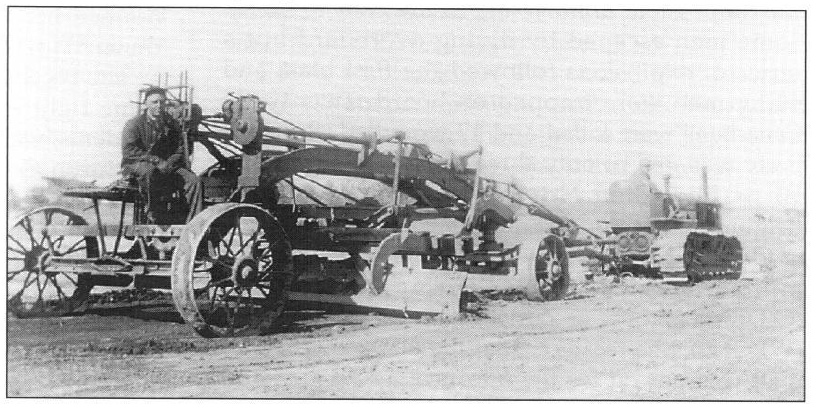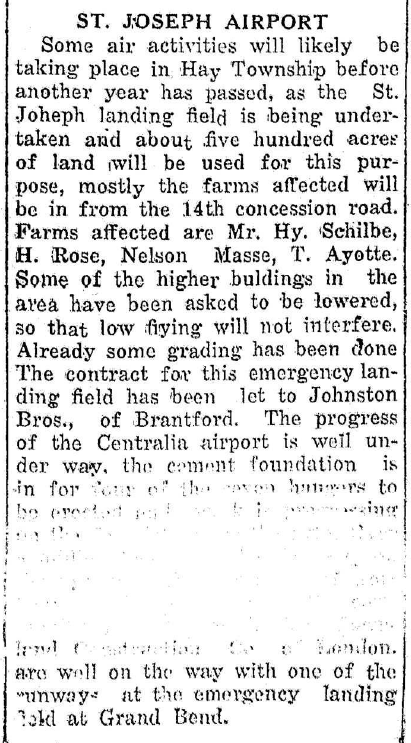In 1939, Prime Minister William Lyon MacKenzie King signed a document which made Canada an active participant in the British Commonwealth’s air training plans. It was simply not safe to train airmen in Britain with enemy aircraft in the vicinity. Britain did not have many trained pilots when World War II broke out and during the Battle of Britain, the Royal Air Force (R.A.F.) suffered heavy casualties. Winston Churchill was referring to the R.A .F. with his famous statement, “Never has so much been owed by so many to so few!”
Canada agreed to establish training bases for the British air crews. Survey crews were sent across Canada to locate suitable sites for these bases. In Huron County, air bases were established at Port Albert, Clinton, Goderich and Centralia. Huron County was selected for its level land and because the high banks along Lake Huron resembled the cliffs of Dover along the English Channel. The local bases would provide similar landing conditions for training the British pilots.
It was not long before the trainers realized that the young, inexperienced pilots of the Avro-Anson bombers of Port Albert; the Fleet two-wing basic training aircraft of Goderich and the more advanced Harvards of Centralia, needed emergency landing fields. The pilots also needed a place to practise landings.
In the fall of 1941, federal government officials showed up on the doorstep of Henry Schilbe, Harry Rose (spelled Rosa on his tombstone), Nelson Masse and Ted LaPorte, in the St. Joseph area. The government wanted the farms, on Lots 21 to 25, Can. 15, as the site for a landing field. To the best of my knowledge, the only farm that was occupied was the Schilbe farm.
This farmland had belonged to the Schilbe family since 1894. Henry had taken it over in 1921 and he and his wife Emma (Wurm) had raised nine children on the farm. The house had been rebuilt and the land tiled but this did not make any difference. The family was told to vacate the farm by the spring of 1942.
Bulldozers, graders and other land-levelling machinery moved onto the farms in 1941. Trailers were set up for the construction crew. Since this base was to be for emergency landings only, not many buildings were required. Firefighting equipment, however, was needed on site in the event of a crash. If there was fire equipment, then you needed airmen there to use it, so eating and sleeping quarters were also built at the rear of the farms. No paved runways were laid down but smooth, packed and possibly grassed runways were built.
The fire equipment was never used for a plane crash but they did respond to local fires such as the Kalbfleisch mill fire in Zurich. The field was in constant use as a place to practise landing procedures such as raising and lowering landing gear, correct approaches, touching down and climbing again. The original field was not large enough so the west 50 acres of Lot 25, Con, 14 was purchased from Nelson Masse. The farm buildings were demolished as a safety precaution. The rear of farms behind the original farms was also purchased.
The Schilbes moved to a farm in the second mile and a quarter south of the Zurich Road. It was later sold to Joseph Miller. Harry Rose had moved to Zurich before his land was purchased to operate a garage, pool room and coffee shop where the municipal building is now located. The former airfield was eventually sold, partly to local buyers and partly to newcomers. It has lost its original shape of 100 acre farms. Otherwise, there is nothing there to show that the St. Joseph airstrip ever existed.
Reprinted from the Hay Township Highlights book.



Thursday, October 23, 1941
